It’s 5:10am and I’m standing thigh-deep in a frigid stream under a road bridge, just a few kilometers north of metropolitan Brisbane. My hands are numb, I’ve barely slept, and in my too-large waders I’m perpetually one wrong step away from face-planting into the water.
But I don’t care… because we just caught a platypus.
The incredible little mammal wriggling in the net at my feet is in trouble — threats like habitat loss, pollution, and drowning in fishing nets are taking their toll on platypus populations, which are declining rapidly across Australia.
That’s why scientist Tamielle Brunt is trapping platypus around urban Brisbane, to try and understand if and how the platypus can live alongside people near one of Australia’s largest cities.
But as I’m learning, trapping platypus is akin to searching for a needle in a haystack. A very sneaky, adorable needle.
Setting the Nets
Our work starts in the afternoon. After a quick safety briefing, we jump into a truck loaded with nets, wooden stakes, warm clothes, and baggy rubber waders. We drive north-east, family suburbs gradually giving way to old farmland, now divided into large blocks with eucalyptus trees shading the lawns. We pass a tractor and road signs warning of koala and kangaroo crossing.
We turn off at a small community park, grab two nets, and set off towards the stream. My borrowed waders are so large that I’m forced to hold them up at the crotch to avoid tripping over them. We make our way down to the stream and, wading in carefully on the rocky bottom, unfurl the fyke nets. They run across the waterway, from bank to bank, guiding any unsuspecting platypus into a funnel that rests half in, half out of the water to allow them to breathe. One net faces upstream, the other downstream to catch platypus moving in either direction.
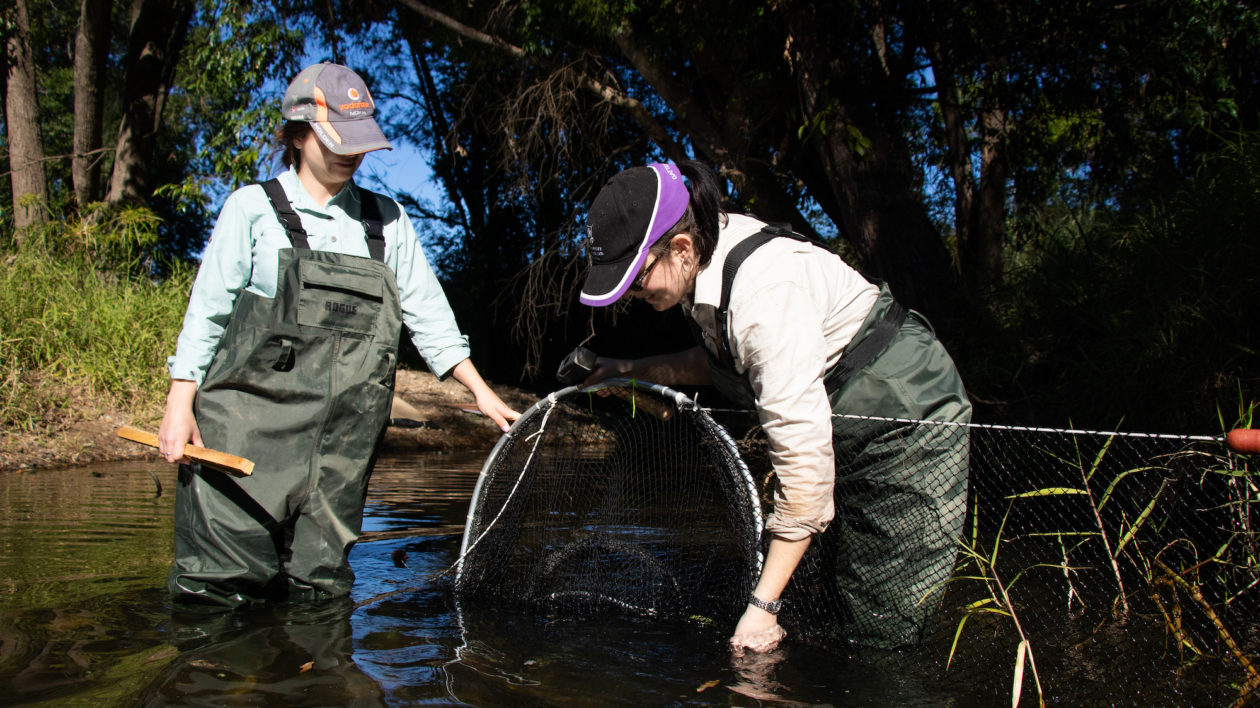
“Try to line it up with that channel, where they’ll be swimming,” says Brunt, as she hammers in a stake on each bank. Volunteer Candice Skelton and I dig around in the murky water for rocks to secure the bottom of the net, our fingers numb from the cold.
It’s winter here in Australia, when platypus are traveling around to find mates. Brunt has just a few months to catch as many animals as possible before the females settle into the burrow with their young.
This is the first of up to eight nets that we’ll put out before dark, spacing them along two different waterways. “Platypus travel quite a few kilometers in a night, so you don’t want the net sites too close together,” says Brunt.
It’s hard work, because the nets require a specific Goldilocks zone: the water can’t be too shallow, too deep, too wide, too narrow, and you need high banks. Otherwise, the sneaky little platypus will just walk around to the other side.
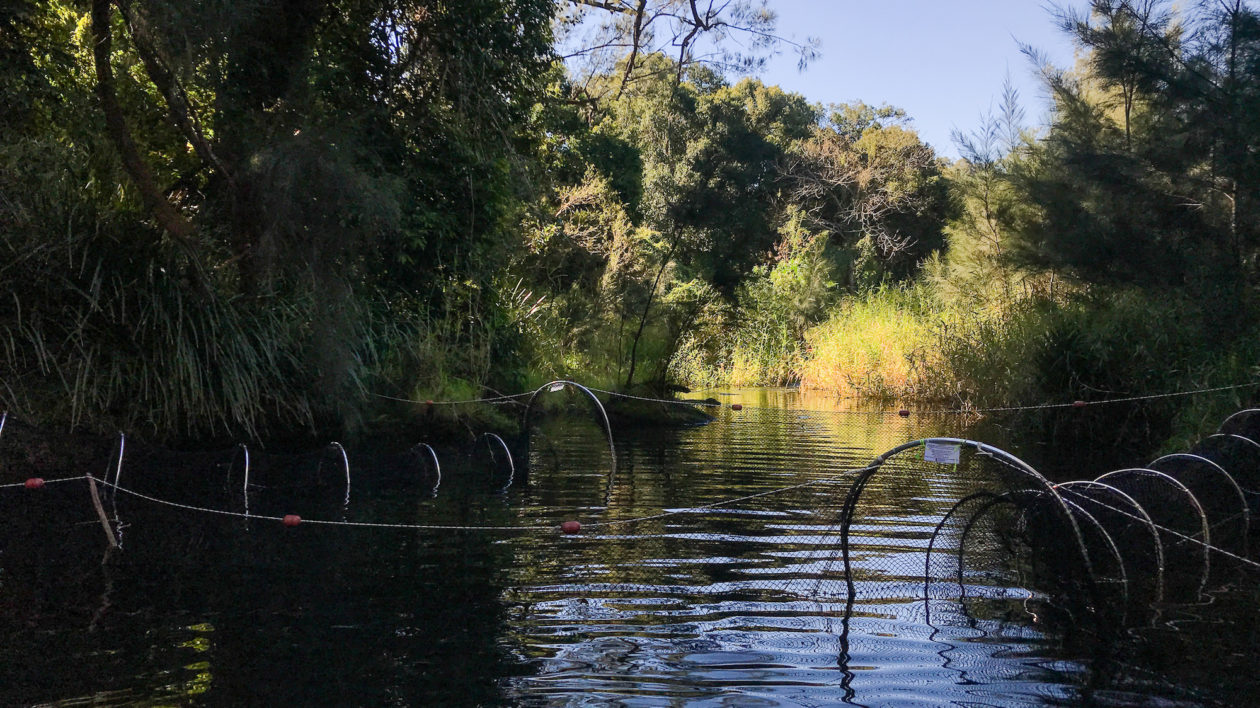
Catching Spiders, Eels, and Cane Toads
After five hours of work we’ve set up five nets, and with dusk falling we return to our AirBnB for a dinner of Instant noodles and toast with cheese. Then it’s back into the car, and into our waders, to do the first check of the night.
It’s dark now, and dozens of spider eyes twinkle in the glow of our headlamps as we scan the water at the first site. Nothing moves in the nets, but Brunt carefully lifts the funnel out of the water to check. “Sometimes they hide from you in the bottom,” she says. No platypus here.
We move from net to net: Drive, waddle, trip, scan the water, lift the net, waddle, drive, repeat. We check the trees for owls as we work, but the night is cold and quiet, lit by a full moon.
This will be our routine for the rest of the night: 2 hours of net checks, 2 hours of sleep, repeat. It’s rough work, and Brunt does it night after night. She’s calm, professional, and thankfully handling the driving. Meanwhile, I sit in the passenger seat, covertly trying to prop my left eye open with my finger and secretly wondering why anyone in their right mind decides to research a nocturnal species.
The 7:00pm and 11:00pm checks turn up nothing, except a few slimy eels and a bulbous cane toad. The 4:00am round will be our last — if the nets are empty, that’s it for the night.
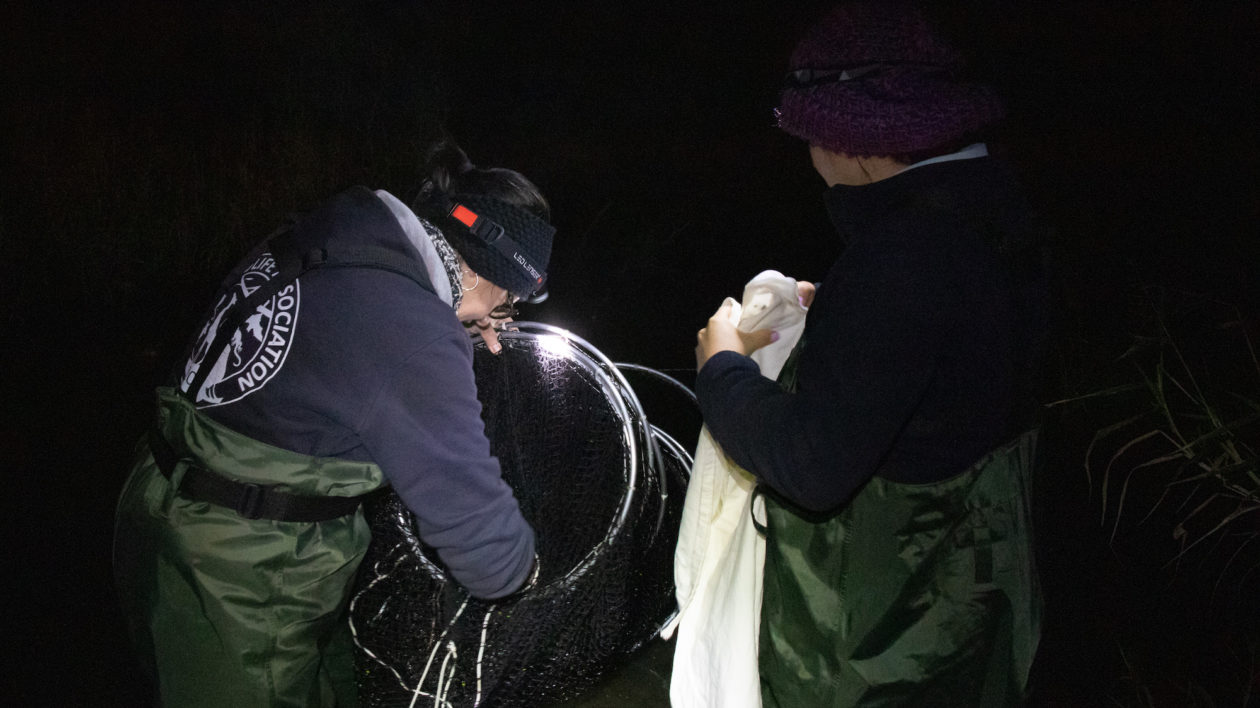
Our First Platypus
Standing under a road bridge, we start pulling up the stakes on the third net. Empty, again. Or so we thought. I’m untangling grass from the netting when I hear Brunt: “Hey guys…. Guess what. I think we have a platypus.”
Skelton and I quite literally trip over ourselves with excitement as we wade towards her. She’s holding the funnel out of the water, peering into the bottom, where something is moving in the beam of her headlamp. The platypus is hiding as best it can at the bottom of the net, holding its breath and remaining motionless, hoping we’ll go away.
Brunt deftly reaches into the net, grabs the platypus by the tail, and plops it into a canvas tote bag. As it wriggles around, its bill pops out of a hole cut into the corner. We’re all relieved — after two weeks of trapping, Brunt has her first platypus of the season.
“Don’t stand too close to the bag, he’s definitely a male,” she says, as we clamber out of the stream and power-waddle back to the truck. Male platypus have half-inch spurs on their hind legs, which they use to jab each other when fighting for mates. Earlier, Brunt was telling us that anyone unlucky enough to be jabbed by a platypus — and injected with the venom — can expect days of pain so excruciating that no amount of morphine will help. Yikes.
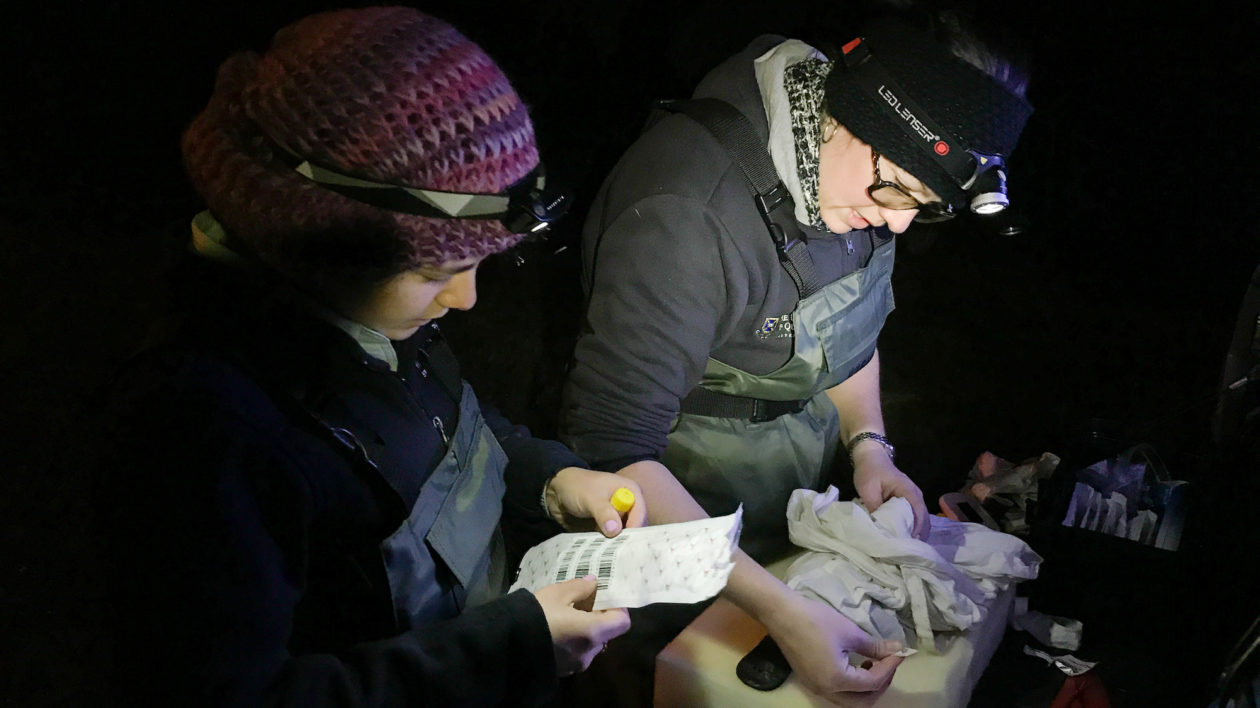
Collecting Data on the Truck-bed
I keep one eye on the bag as Brunt opens up the back of her pickup truck and sets the platypus down on a foam pad. We have a lot of data to collect, and we need to work quickly.
First Brunt weighs the platypus, looping the bag around a handheld scale. “How heavy are you? 1.175 kilos? Jeeze, you’re big!” she says, as the bag wiggles slightly.
Next, age and fat reserves: Male platypus can be aged by their spurs, which have a keratin sheath that wears away as they mature. This little guy is a juvenile, between 9 and 12 months old.

Platypus store fat in their tails, so Brunt folds his tail like a taco to see how much it bends. He doesn’t have significant fat reserves, but looks healthy otherwise, with a lush coat free of ticks and parasites. “He’s not even breeding age yet, so maybe he’s just trying to set up his own territory,” she says.
The little male starts to wiggle around again, and Brunt waits for him to settle before measuring his bill and body. I lean in close to get a better look at the bill. The grey-brown surface is covered in tiny little pores, which platypus use to sense electrical signals in the water.
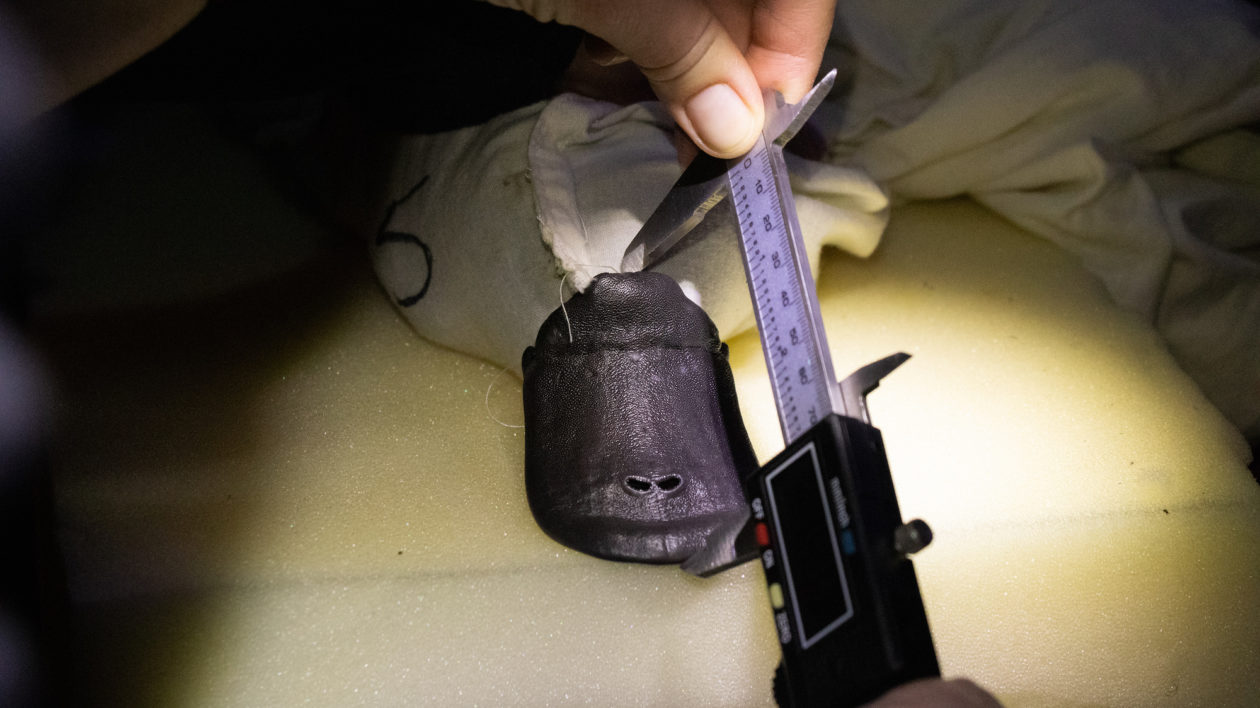
Next, Brunt takes hair samples from the body and tail, which will be used for a toxicology analysis, and a skin sample from the hind webbing, similar to a human cuticle, for genetic analysis.
The last step is the microchip. Brunt takes out a small plastic scanner and runs it over the platypus’s body, searching for any previous microchips. As she places her hand gently on his head, the platypus sneezes loudly. “Oh bless you! Is this because I’m on your schnoz?” says Brunt, laughing.
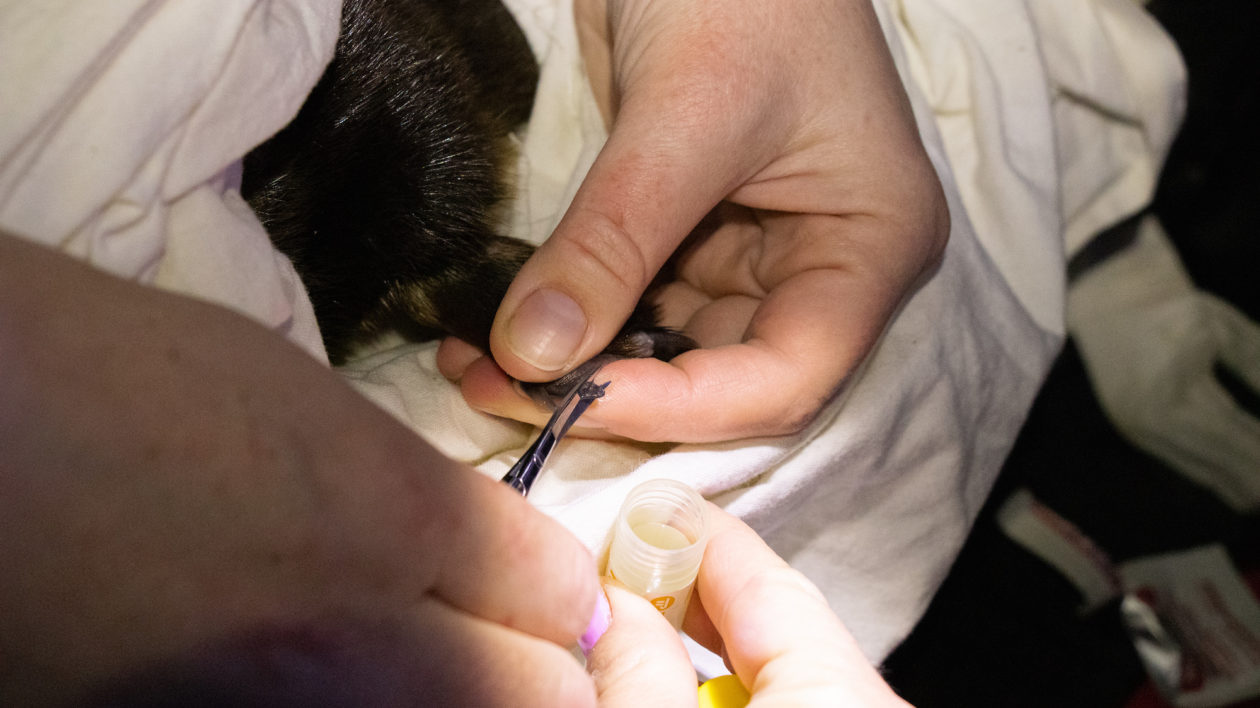
Not surprisingly, he hasn’t been tagged before. Brunt tells us that very little research has been done on platypus in Queensland, which means conservationists don’t have the data they need. “We don’t know things like population structure, genetics, all of that baseline data that are so important to manage these populations and let them persist into the future,” says Brunt.
The data we collect tonight is the first step in filling some of those knowledge gaps. And so this little platypus needs a microchip.
Brunt carefully folds up the skin around the back of the animal’s neck, needle at the ready. “The cheeky buggers,” she says, “they don’t have a lot of skin to begin with, and then they hunch themselves up sometimes.” A quick pinch and then it’s over. Brunt waves the scanner over his back again and the display lights up with the serial number.
He’s ready to go.
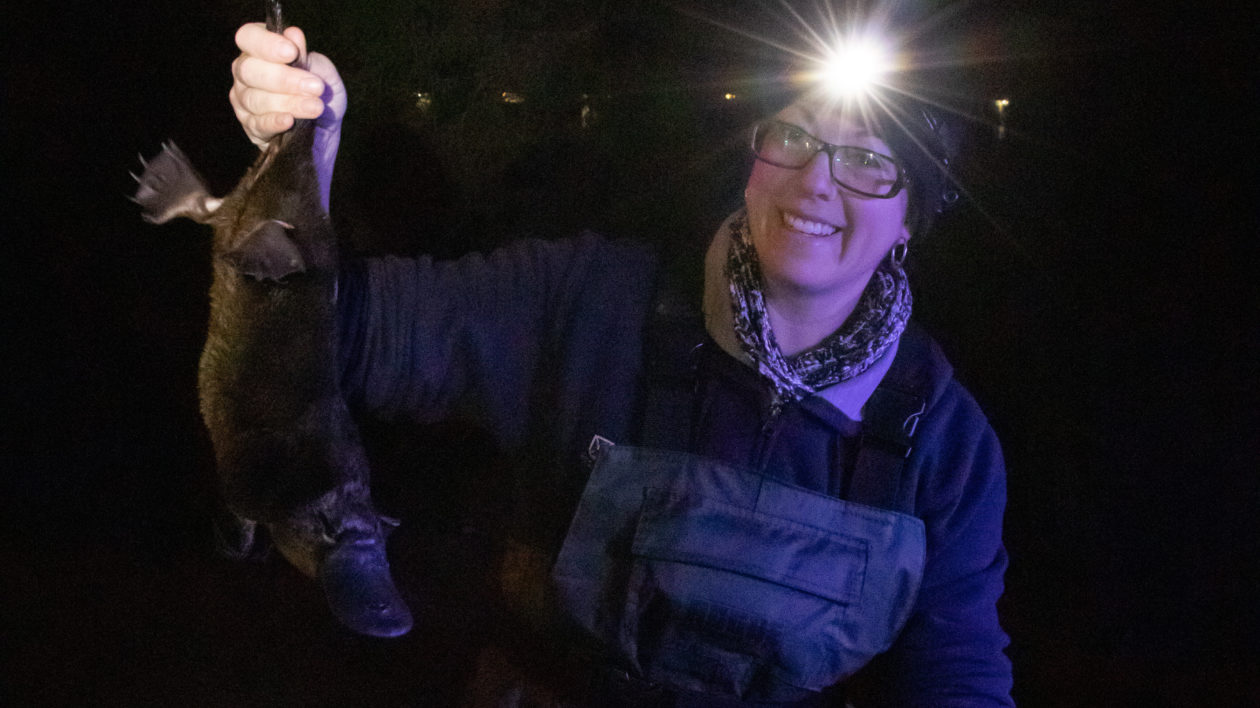
Return to the River
It’s almost dawn when we shuffle back down to the stream to release the platypus. Early-morning joggers run past in their fitness gear, as the first commuters drive overhead.
We walk past the half-uprooted nets to a deeper pool. Brunt sets the bag down on the sandy bank and opens the ties. A snuffling bill emerges, then a head, then a glossy brown body. The platypus ambles out of the bag, quite calm despite all our prodding, and down to the water’s edge. He slips beneath the surface without a splash, and within seconds he’s disappeared into the murk as if by magic.
On the way back to the car, stifling my yawns, I ask Brunt why she chose to work on platypus.
“Because I’m nuts!” she quips. Then she says: “I first went out volunteering on platypus fieldwork in 2014 in the Grampians. When you’re up close and personal with one for the first time…. I held this little female and I just had a moment. I was like wow, this is it.”
I know what she means. It’s one thing to read about platypus — their weird bills and spurs and all the rest — but it’s another thing to see one up close. They’re as endearing as they are bizarre; special, in a way that I just can’t quite put my finger on.
And hopefully, with Brunt’s help, Brisbane’s platypus will be here for a long time to come.
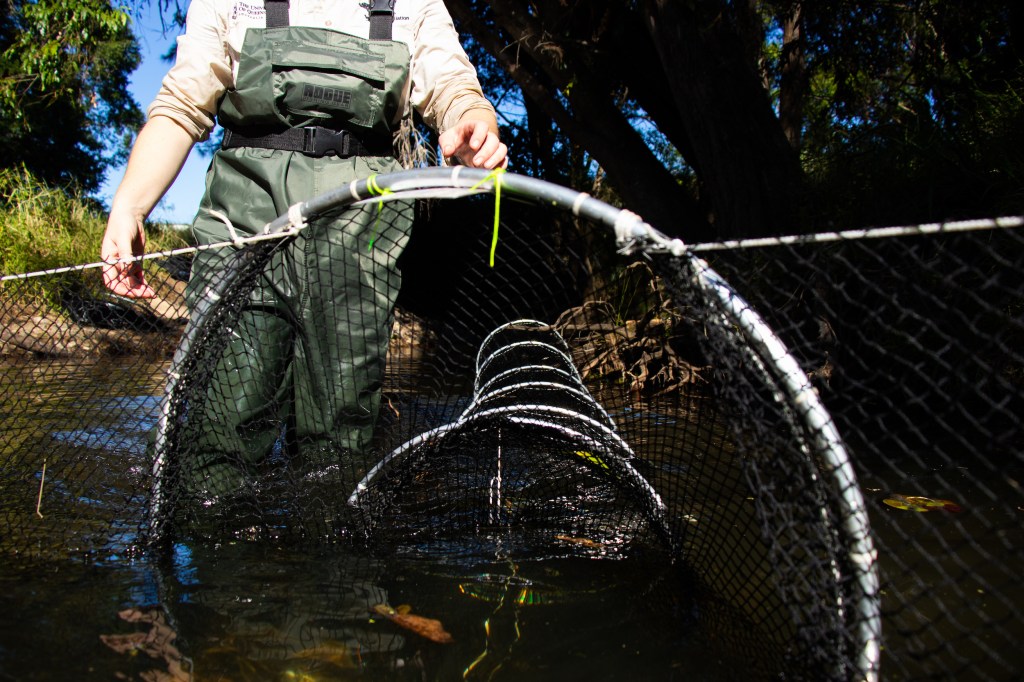



Tamielle Brunt, Volunteer Candice Skelton and of course our award-winning science writer for The Nature Conservancy Justine E. Hausheer, I thank you for your amazing efforts, professionalism, time, dedications and sacrifices you have all performed. Most importantly, the contributions you are making regards to the awareness and prevention of all inhumane senseless acts of animal cruelty.
===========================
Today whilst checking out the water levels and various amazing waterlife i my local creek, I stumbled across accross (or should I say he stumbled accross me) a young adult male platypus, swirling around my ankles with a keen curiosity of his surprising guest. I’m quite used to this as are, a few of the local platapy..
Today while giving a lite scratch / rub on his furry litle back I could not help but notice something was different. I had spotted a few small thin strands of mono fishing line wrapped around his little belly..
I was disgusted in what was happening. The hardest thing to hit me was the fact this BEAUTIFUL CARING LITTE CREATURE WAS SO DELICATE AND COULD NOT SEE THE SLOW, CRUEL PAINFULLY INHUMANE FATE HE WOULD HAVE BEEN DESTINED TO SUFFER IF I HAD NOT FOUND HIM AND MOST IMPORTANLY LOOKED TWICE..
I urge everyone to pay attention and look twice when amonsgt our wildlife to carefully eximine them even if only with your eyes and ears and do your utmost best attempt to understand if the animal(s) in question are showing “ANY” signs of injury, entanglement etc, as I found out today, sometimes the poor little critters aren’t even aware yet of the seriousness they are about to endure, and believe me that “IS” the crushing bit that “HURTS” me the most of all.
Remember, don’t be afraid to ask someone for their assistance i n double checking if the animal is injured etc and if unsure, “ALWAYS” make a quick phonecall to you nearest “WILDLIFE PROTECTION AND RESCUE ORGANISATION”.
Luckily after learning a few valuable lessons here. I have very carefully removed the entangled fishing lines from the little platypus and am going to release him back to his exact location after a final double check on him and this final mesage..
==========================
In todays day and age I find it quite unsettling to (not only think, but) know that the vast majority of people ideed need be “Made aware of)” letalone be reminded:
“We are the voices and protectors of everything Mother Nature has provided for” us” both aniamals, (all creatures great and small) as well as caretakers / custodians of this beautiful yet, fragile planet earth “we” call home..”
“us” = Everything Mother Nature has provided.
“we” = Most certainly are “NOT” everything Mother Nature has provided although, if we as humans continue living our lives as ignorant, arogant, selfish, obnoxiously blinded by greed, lusting for status with one tracked packed mentality where each and every days waking concern(s) revolve around FOMO, then:
“WE” = will, inevitably be the “ONLY” pieces of rubbish left for Mother Nature to…..
##########
It’s time!!
##########
… Yes yes I know now that, you know now that, I could continue my little rant considerably more as we here all know how important it is to be the voices, protectors , caretakers and custodians for everything (even each other).
So it seems it’s up to individuals like ourselves to be the voices for all, the voices to all. .. Maybe so…
#########################
Thanking all readers and participants.. Please do your best
to keep this message alive and well for all to see hear…
Much appreciated.
Best regards,
(BD) aka Brendon Roberts
>8-D
A huge ‘thank you’ to all three researchers and a young platypus fellow for this wet, frigid adventure and for inspiring us to appreciate and work to save Mother Earth’s beings .
Thank you for sharing ….a wonderful article on a very special little creature. Keep up the good work.
What a pleasure to read!
Bless their little hearts – and those of the researchers working to save them.
This is so cool. I just increased my platypus knowledge many times over. We don’t have them in Texas, USA:(